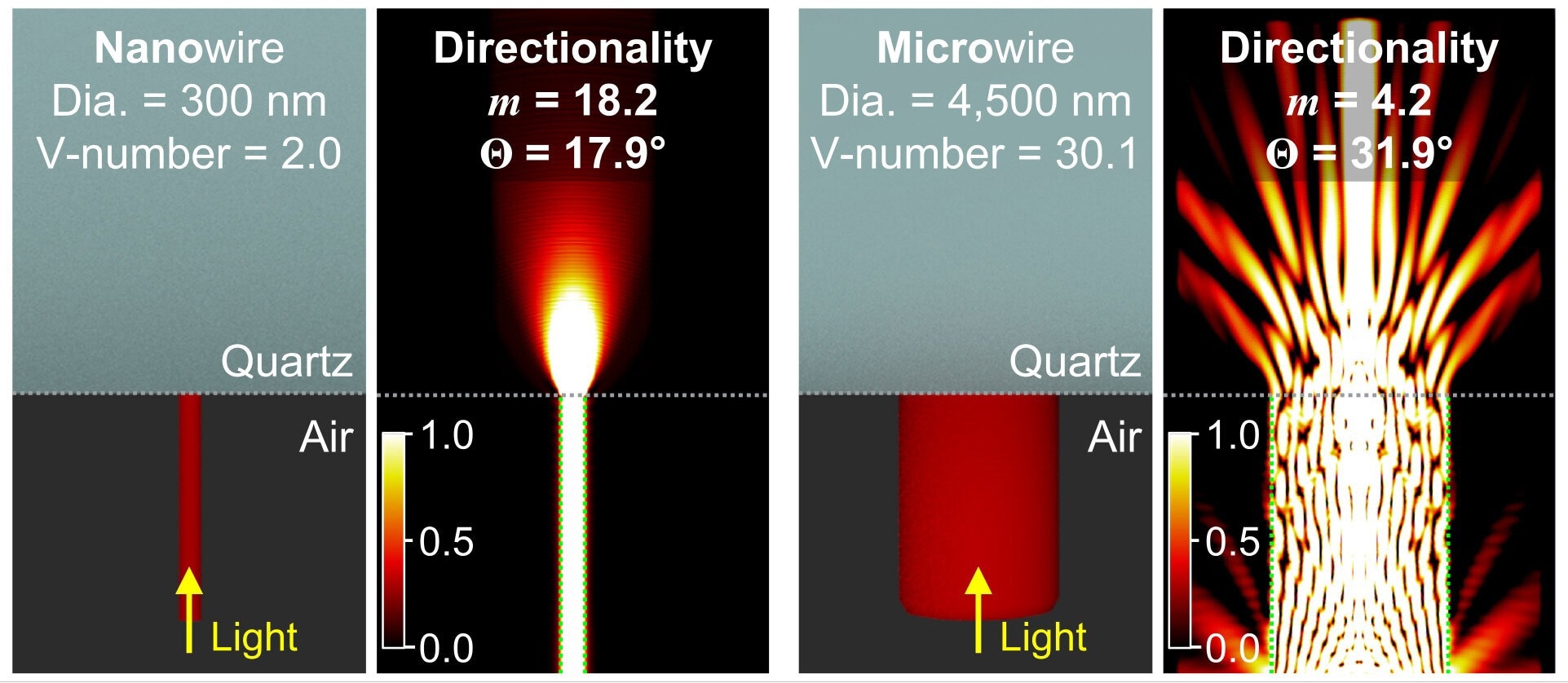An international team of researchers under Dr. Jaeyeon Pyo, from the Korea Electrotechnology Research Institute became the first in the world to disclose light emission patterns from 3D-printed nanowires. The journal ACS Nano published this study.
 Comparative simulation result of the light propagation and its emission from a nanowire (left) and microwire (right). Image Credit: Korea Electrotechnology Research Institute
Comparative simulation result of the light propagation and its emission from a nanowire (left) and microwire (right). Image Credit: Korea Electrotechnology Research Institute
More pixels fit into a given screen size in higher-resolution display devices. As pixel density rises, movies and images are shown more accurately and in detail. Creating smaller light-emitting devices, from the µm (one-millionth of a meter) to the nanoscale (one billionth of a meter), is the goal of current research in this area.
When light-emitting devices get smaller, down to hundreds of nm, distinct alterations arise in the interaction between light and matter, leading to notably distinct emission patterns when contrasted with macrostructures. Thus, knowledge of light emission from nanostructures is a necessary precondition for using nanoscale light-emitting devices in real applications.
The extremely directional light emission patterns from the 3D-printed nanowires were first seen by the KERI research team, which had spent years employing nanophotonic 3D printing technology for display research.
Generally speaking, it is difficult to use traditional chemical or physical vapor deposition techniques to produce light-emitting materials of specified sizes at specific places consistently, but with KERI's 3D printing technology, the diameter can be precisely controlled by limiting the printing nozzle's aperture, which makes it possible to dependably fabricate light-emitting materials in a variety of sizes and at desired locations (diameters ranging from 1/10,000th to 1/10th millionth of a meter).
The group led by Dr. Jaeyeon Pyo experimentally examined and quantified light emission patterns from specimens that ranged in size from nm to µm and were carefully manufactured utilizing the nanophotonic 3D printing technique. The group also ran electromagnetic wave simulations to analyze and cross-validate their claims thoroughly.
The internal reflection of light disappears owing to spatial confinement when light-emitting materials are as small as 300 nm in diameter, resulting in one-directional straight light transmission. As a result, the pattern of light emission becomes very directed.
Light usually travels along channels inside a specific internal structure, superposing to form broad emission patterns. Nevertheless, in nanowire formations, the highly directed emission pattern results from a single route.
The observed highly directional property can greatly improve the functionality of encryption devices, optical storage systems, displays, and other equipment. When densely integrated, macro-structures with broad emission patterns may experience optical crosstalk, which results in signal overlap or blurring.
On the other hand, signals from each structure may be distinguished at high densities, thanks to highly directed emission patterns on nanowires, which removes any distortion in representation or interpretation. KERI's team has proved experimentally that nanowires are suited for high-performance devices due to their highly directed emission.
Research on optical physics at the nanoscale is challenging, especially due to the difficulty in specimen preparation, which is often high-cost and time-consuming. Our contribution demonstrates that the 3D printing method can be a versatile platform for studying optical physics owing to its simple, flexible, and low-cost characteristics. This research will significantly contribute to the cutting-edge display technologies, and quantum physics, which are part of South Korea's 'National Strategic Technology Nurture Plan.
Dr. Jaeyeon Pyo, Electric Energy & Materials Engineering, KERI School, University of Science and Technology
The research team believes that since ultra-small light-emitting materials can be used in these domains, their contribution will be of great interest to those working in the fields of virtual reality (AR, VR), beam projectors, optical storage media, photonic integrated circuits, encryption technologies, and security printing.
They want to use 3D printing to continue studying different optical phenomena that happen at the nanoscale and to take advantage of its free-form production capabilities.
Journal Reference:
Bae, J., et al. (2024) Emission Directionality of 3D-Printed Photonic Nanowires. ACS Nano. doi.org/10.1021/acsnano.4c02820.